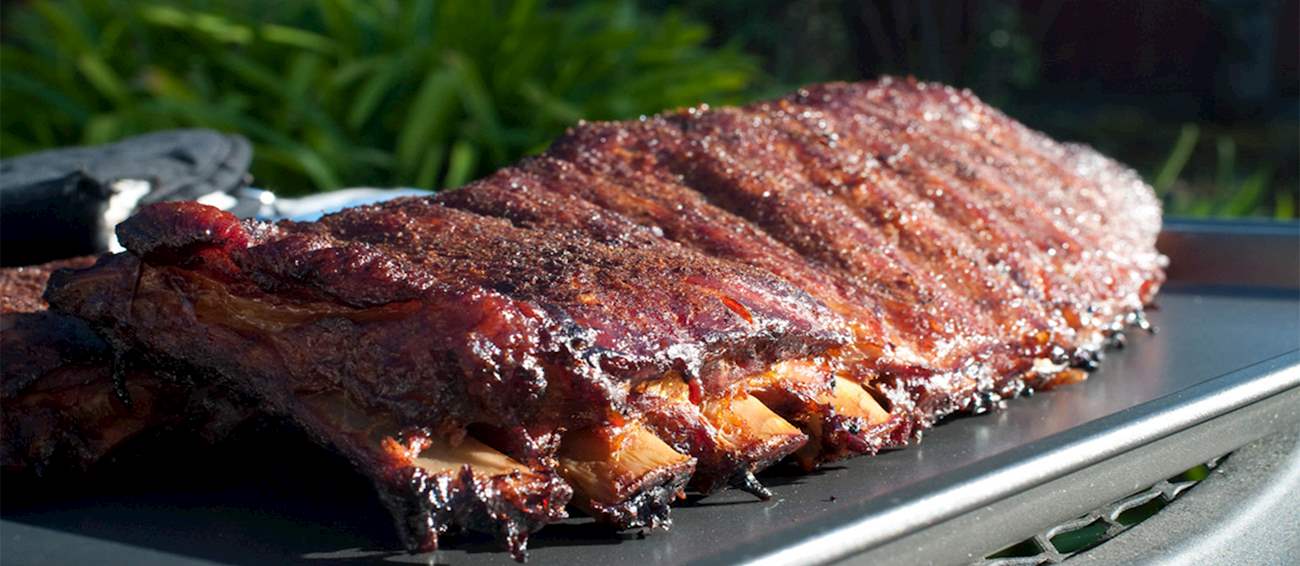MAIN INGREDIENTS
Pulled pork is an American barbecue technique of cooking pork meat slowly over low heat, resulting in tender meat that can easily be pulled into small pieces. It is a specialty that originates from the western part of North Carolina, traditionally using shoulder cuts of pork which are dressed with a vinegar, pepper, and tomato sauce.
In the eastern part of the state, the whole pig is cooked and pulled, while the sauce usually doesn't contain tomatoes. Over time, it spread throughout the United States, and pulled pork can be found in many variations, ranging from different cuts of meat and cooking times to marinades and sauces.
MOST ICONIC Pulled Pork
View moreMAIN INGREDIENTS
St. Louis-style ribs are pork spare ribs that are trimmed down into uniform, almost perfectly rectangular pieces of meat. Before being placed on the grill, the meat is typically seasoned with salt or rubbed with selected spices, and it is then brushed with barbecue sauce which should be sticky, sweet, and slightly acidic, usually based on tomatoes.
When fully tender and juicy, these mouth-watering ribs are ready to be carved and enjoyed, preferably served with even more barbecue sauce for dipping.
MOST ICONIC St. Louis-Style Ribs
View moreNorth Carolina barbecue can be split into two halves – in the east, they use the whole hog, while in the west, also known as Lexington-style barbecue, smokes only the pork shoulder. Eastern barbecue is usually chopped with a vinegar-and-spices-based sauce, while Lexington-style is typically used for sandwiches with a tomato-based sauce.
This is probably the oldest type of American barbecue, and the wood used for it is often hickory or oak.
Kalua pig is a traditional Hawaiian dish where a whole pig, seasoned only with Hawaiian sea salt, is placed inside a large pit that has been dug in the ground. Heated lava rocks are placed in the pit, with the insulation cover made from banana or ti leaves.
The pig is then covered with more insulation and soil and is left to slowly roast through the day. The word kalua from the name of the dish refers to cooking in an underground pit, called imu in Hawaiian. The pig is usually served at special events, parties, and family gatherings, accompanied by steamed rice and taro root paste.
South Carolina barbecue is mostly based on pork. Sometimes it's pulled from a whole hog and sometimes the meat is chopped from a shoulder or ham. The meat is traditionally cooked and smoked over hardwood such as oak or hickory. What sets apart South Carolina barbecue from North Carolina-style barbecue is the yellow Carolina Gold sauce in the Midlands, consisting of cider vinegar, yellow mustard, spices, honey, and brown sugar, while the Pee Dee region uses a fiery sauce based on vinegar and pepper.
MAIN INGREDIENTS
Fatback is firm and dense fat taken off the back of a pig, and can be bought with or without the skin. It can be used to make salt pork or lard, and it is sometimes used for techniques such as larding and barding. Fatback is also the name of a traditional dish that is served for New Year's Eve in the American South, when it is fried until golden-brown and crunchy, accompanied by black eyed peas and greens.
The dish is supposed to bring luck and wealth in the year that follows. Originally, fatback became popular in the South during the Great Depression because it was the only cut of meat that hungry families could afford.
MAIN INGREDIENTS
Smothered pork chops is a traditional dish from Louisiana consisting of pork chops smothered in rich gravy. Although there are many versions of this dish (and just as many recipes), it is usually made with pork chops, onions, celery, bell peppers, garlic, flour, water, and Creole seasoning.
The pork chops are fried (often in bacon grease), smothered in gravy, then served, either as a dish in itself, or accompanied by rice, field peas, or smothered potatoes.
MAIN INGREDIENTS
Who thought that only six ingredients in a can would become America's national dish? The square-shaped mixture of pork, water, salt, sugar, potato starch, and sodium nitrate called Spam sold more than eight billion cans since the product was made available in 1937.
Cooked under vacuum pressure, this great source of protein was invented by Jay Hormel, who canned the shoulder of a pig with added spices, regardless of his competition that used lips, snouts, and ears in their cans. As a way of separating his product, he decided to reduce the size of the can and design a visually attractive label.
MAIN INGREDIENTS
Stuffed ham is an American delicacy originating from a small area in southern Maryland (the counties of St. Mary's, Charles, and Calvert) and dating back to the 17th century. The ham is brined in salt, trimmed, sliced, then stuffed with a combination of kale, cabbage, onions, celery, hot peppers, and various spices.
It is traditionally wrapped in cheesecloth, boiled for a few hours, then served cold as a main dish or tucked into potato rolls or between slices of bread. The dish is usually prepared for the festive Christmas season. Although not much is known about the origin of stuffed ham and there are numerous variations on the dish, it appears to combine British and African traditions – the ham is similar to Lincolnshire stuffed chine, while the hot peppers suggest a possible Caribbean and African influence.
MAIN INGREDIENTS
This festive Chamorro dish is made by slowly spit-roasting a whole pig over an open fire. The pig is usually continuously basted in order to develop crispy skin on the outside and tender, succulent meat on the inside. For a 100-pound pig, it typically takes four hours to roast it.
When served, the pig is placed on a tray that is often decorated with various fruits, and it is then set as a central element on the festive table.
TasteAtlas food rankings are based on the ratings of the TasteAtlas audience, with a series of mechanisms that recognize real users and that ignore bot, nationalist or local patriotic ratings, and give additional value to the ratings of users that the system recognizes as knowledgeable. TasteAtlas Rankings should not be seen as the final global conclusion about food. Their purpose is to promote excellent local foods, instill pride in traditional dishes, and arouse curiosity about dishes you haven’t tried.






